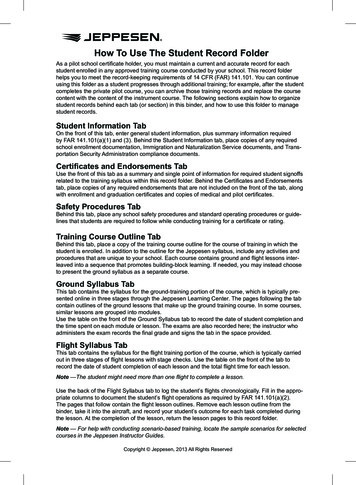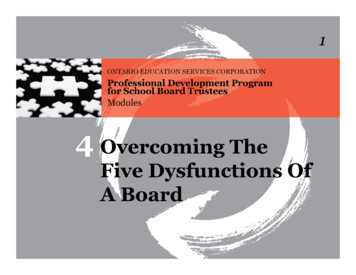
Transcription
Common Ground HealthCase StudyAbout This Case StudyThese case studies were authored as a part of the evaluation of ReThink HealthVentures, a three-year project of The Rippel Foundation, conducted with supportfrom the Robert Wood Johnson Foundation, to explore what could acceleratethe progress of ambitious multisector partnerships working to transform healthin their regions, and what often stands in the way of that progress. Through theproject, Rippel’s ReThink Health initiative supported multisector partnerships insix regions across the country as they worked to build practices that are essentialfor transforming a regional health ecosystem, including broad stewardship, soundstrategy, sustainable financing, and a shared vision. Each participating partnershipselected a handful of members to participate on the Ventures Team for their region.Those teams collaborated with ReThink Health and their broader partnershipsthroughout the project. Mount Auburn Associates served as the project’s learningand evaluation partners.We have authored case studies about each of the six partnerships to highlighttheir unique journeys toward health transformation, with a particular focus ontheir work in Ventures, as well as insights that can be applicable to a wide rangeof stewards working to transform regional health ecosystems across the UnitedStates. You can find the other case studies, along with a detailed evaluationreport about ReThink Health Ventures, at www.rethinkhealth.org/ventures.We are grateful for the time and energy that so many people contributed tosupport the development of these case studies. Most importantly, the authorswould like to thank the leaders who participated in Ventures for their tirelessdedication to transforming health and well-being in their communities.
May 2019Common Ground Health Case StudyFinger Lakes, NYBy Beth Siegel (Mt. Auburn Associates) and Jane Erickson (ReThink Health)OverviewNew York’s largely rural Finger Lakes region, whichincludes a nine-county area as well as the city ofRochester, has a long history of collaboration toreduce health-related costs and improve healthoutcomes. This history began over 50 years ago,through the leadership of the region’s largestcompanies, such as Eastman Kodak. A number ofcase studies have been written about why the region,and Rochester in particular, “leads the country as abeacon of high performance on cost and quality.”1According to one of these cases, “The Rochester storyreflects a local culture that has been built where allstakeholders recognize that we are all in this together.”2The ReThink Health Ventures team supported oneof the region’s core health transformation organizations,Common Ground Health, through a strategic planningprocess. A cross-sector board of directors, comprisedof health care providers as well as leaders in education,business, and human services, leads Common Ground,which has its roots in facilitating regional planningaround health care facilities and technology capacityplanning. Board members saw an opportunity throughVentures to address a number of questions, including:“What has Common Ground’s historical role been,what is its current role, and what should its role begoing forward?”ContextCommon Ground serves a broad geographic area,including nine counties with both urban and ruralpopulations. Additionally, the region has a strong historyof health care cost containment and collaboration tosupport outcomes related to the Triple Aim (lowercosts, better outcomes, and improved patientexperience). Today, particularly in Rochester, there area large number of cross-sector partnerships designinginnovative efforts related to the social determinantsof health, systems integration, shared data systems,and health disparities. This context plays an importantrole in understanding the work of Common Groundin Ventures.1 Morrison, Ian, Ph.D., Ian Morrison on Community Collaboration forHealth Care. Hospitals & Health Networks (H&HN), December 1,2017; Hall, William J. and Paul F Griner, Cost-Effective Health Care:The Rochester Experience. Health Affairs, Spring 1993.2 Ibid.3 U.S. Census, American Community Survey 2013-2017.VENTURES CASE STUDIES Common Ground Health Case Study ReThink HealthVENTURES TEAM, GEOGRAPHIC SCOPE Ventures Team: Common Ground leaders, including executivedirector, director of strategic initiatives, and director ofresearch and analytics; current Common Ground board chairand leader at a regional school of nursing; Common Groundboard chair elect and leader at major health care system;Common Ground immediate past board chair and leaderin the business community Geographic Scope: New York’s Chemung, Livingston, Monroe,Ontario, Schuyler, Seneca, Steuben, Wayne, and Yates countieswww.commongroundhealth.org/Community Context: The Finger Lakes region has apopulation of 1,279,000 people living in nine counties.Monroe County is the most densely populated; itincludes Rochester, the third largest city in the state.The eight other counties in the region are predominatelyrural, with populations ranging from 18,000 to110,000. The area’s demographic profile has changedlittle over the years, except its total population hasdeclined relative to that of New York state—depressingthe region’s economy.3 The region is predominatelywhite with eight of the nine counties estimated to have88.3 to 96.7 percent of their populations identifyingas white and only 1.7 to 4.1 percent identifying asHispanic. Monroe is the largest and most diverse with24 percent of residents identifying as non-white andnearly 8 percent identifying as Hispanic.For many years, Rochester was home to theheadquarters of manufacturing giants Eastman Kodak,Bausch Lomb, and Xerox. At its height, in the 1980s,Kodak employed 60,000 workers in the region.George Eastman, Kodak’s founder, held a prominentposition in the community, and local stakeholdersworked closely with and were greatly influenced bytheir colleagues in the business community. However,manufacturing began a steep decline in the early2000s. A large number of jobs were lost as a result ofcorporate bankruptcies, including at Kodak; mergersthat led to companies moving away from the region;and companies such as Xerox making significant cutsto their local workforces. Though some manufacturingjobs have been added back, the manufacturing sectoroverall is expected to continue its decline, and thearea’s large manufacturers no longer have the influencethey once did. Instead, other employers, like Paychex,Wegmans, and Constellation Brands, as well as theregion’s two health care systems, Rochester Regional2
Hospital and the University of Rochester MedicalCenter, have begun to rise in regional significance.The region’s largest employment sectors are nowhealth care and social assistance, accounting forapproximately 85,000 jobs in the Rochester metro politan area, according to 2018 data from the NewYork State Department of Labor. 4Political and Institutional Context: The Finger Lakesregion has a relatively complex and mature healthecosystem, with a number of closely related crosssector initiatives in addition to several well-establishedhealth care players. A number of well-establishedpartnerships are designing innovative effortsaddressing the social determinants of health, systemsintegration, shared data systems, and health disparities.Common Ground has an especially long history inthe region, emerging from a health planning councilcreated in 1961 by community leaders and led by thedirector of Eastman Kodak Co. The 1974 NationalHealth Planning Law officially designated this councilas the Finger Lakes Health Systems Agency (FLHSA).The FLHSA, which changed its name to CommonGround Health in 2017, is the last remaining healthsystems agency in the nation.5Common Ground is overseen by a cross-sectorboard of 23 community leaders, including represent atives from hospitals, payers, local businesses,government agencies, and service providers. It workswith an additional 240 partner organizations andbusinesses to improve access to and quality of careand better health outcomes for all through population based analytics, cross-sector collaboration, and healthcare practice transformation. To support its communityengagement efforts, Common Ground also overseesthe African American and Latino Health coalitions andthe Partnership for Access to Healthcare (PATH), whichall focus on issues related to health disparities. WhileCommon Ground has evolved considerably over thepast decade, it uses the Triple Aim goals to guide itshealth care strategy. Much of its work to date hascentered on efforts focused on health care delivery.Advancing Health Transformationwith ReThink Health VenturesThe Ventures experience has transformed howCommon Ground’s leaders see their role. They haveshifted their vision, viewing the region more as acomplex health ecosystem—consisting of a widerange of organizations and partnerships working tobroadly support health and well-being for all residents4 https://www.labor.ny.gov/stats/cesemp.asp5 Established in 1974, HSAs were formed to provide local directionand control of health care planning in regions across the U.S.In 1986 HSAs lost their legislative authorization and federalfunding ended. States were free to maintain HSAs with their ownresources.VENTURES CASE STUDIES Common Ground Health Case Study ReThink Healthin the region. They have come to appreciate moredeeply that they are one of many important groupsworking to help that ecosystem to thrive, and canplay a more effective leadership role by strengtheningthe network of organizations working to bolster theecosystem. The story of how the leaders of thisorganization, one of the oldest health transformationentities in the U.S., have come to embrace the conceptof distributed leadership as a means to rebuilding asense of shared ownership for regional health trans formation efforts, provides insights into the need to beadaptable and strategic in light of the changing regionalcontext when working to transform regional health.How leaders are working differently1. Embracing distributed leadership as a modelfor regional stewardship: Common Ground’sleaders have shifted their mindset about their rolein the region, realizing that they do not need toalways lead directly, and can instead advocatefor and model distributed leadership. Within adistributed leadership structure, the work happening within and across collaborative partnershipsin a region to achieve a common purpose aredistributed among many groups and individualsrather than owned by a single entity. Distributedleadership shifts focus onto relationships amongmany parties, with each taking some responsibilityfor leading on behalf of the whole and buildingalignment through relationships and mutualcommitments.Perhaps the greatest impact resulting fromCommon Ground’s work with Ventures was theorganization’s new approach to regional steward ship, which is anchored in distributed leadership.Developing this practice meant recognizing thatthe existing network of trusting relationships in theregion needed to be strengthened. The Venturesteam realized that, while there was a broad baseof influential stakeholders in the Finger Lakes, theywere not collaborating effectively. One boardmember remarked,“[We have moved] from being reactionary ordefensive and needing to define our territory . . .to saying there is a lot of good work going on.Let’s bring in everybody. Let’s make a bigger tentand support other groups, help them see commonparts that should be worked on in a broader senseby the whole community.”This practice has encouraged a shift in howCommon Ground participates in a number ofregional initiatives. New conversations betweenCommon Ground and Rochester Health InformationOrganization (RHIO), the Finger Lakes PerformingProvider System (FLPPS, an initiative supportingregional Medicaid reform), and the Rochester 3
Monroe Anti-Poverty Initiative (RMAPI, coordinatedby the United Way) indicate that stakeholdersin the region are now better prepared to workacross organizational boundaries in ways thatwere not possible even a short time ago.Conversations about how each of these groupscan support a shared vision around health systemtransformation have brought greater clarityregarding each organization’s unique roles andresponsibilities. Common Ground is acting as asubject matter expert across multiple initiatives,providing data, analysis, and strategic thoughtpartnership with key leaders. Additionally, theorganization is making Whole Child Health (whichsupports a holistic view of children’s health thatincludes physical, cognitive, social-emotional, andbehavioral health) a major priority, but rather thanassuming it needed to lead this work, it is workingwith others to support ongoing activities.2. Incorporating strong system thinking: CommonGround staff, board members, and many of theboard members’ organizations have developeda deeper appreciation and understanding ofsystem thinking and system approaches.Common Ground’s work to develop a theoryof system change through Ventures helped to shiftboth mindsets and actions across the organization,including the board. The effort involved understanding how the many forces that shape healthin a region can work together effectively as asystem. This pushed the thinking of the team andreinforced the importance of taking a systemapproach in the strategizing, planning, andimplementation of their work. Looking at themultiple systems impacting health and well-beingled Common Ground into some new areas, suchas prioritizing new work around the region’s foodsystems and included convening a partnershipto address access to healthy and fresh foods.Common Ground’s leaders have noted that thesystem thinking approach helped to also changethe perspective of the organization’s board ofdirectors. “The upstream is where [staff’s] heartswere, but, for some of the board members, it wasa little hard to really give us permission to gothere because it wasn’t traditionally what we’vebeen doing,” said one team member.Common Ground has also established astanding internal group, comprised of theorganization’s staff, tasked with ongoing strategicplanning that looks at its entire portfolio overmany decades. The board now sees strategicplanning not as a once-every-three-years process,as it had been prior to their work with Ventures,but as an “evergreen function.”VENTURES CASE STUDIES Common Ground Health Case Study ReThink Health3. Adopting a more ambitious agenda, movingto a broader set of vital conditions that helpresidents of a community to be healthy and well(such as early childhood development) and adeeper commitment to achieving health equity:The organization is now supporting work acrossmany of the systems impacting health andwell-being, including transportation; communitydevelopment; housing; and systems integrationinvolving health, human services, and education.Common Ground’s executive director WadeNorwood reported that, prior to working with Ventures,“[Upstream work] tended to be trumped by the clinicalwork and by the programmatic intervention, asopposed to the policy intervention.” The process ofdeveloping a shared value proposition narrative, rootedin an aspirational and long-term view of the futureand recognizing what the organization needed toshift to get there, was significant to the evolution ofCommon Ground’s thinking. The value propositionnarrative helped to strengthen Common Ground’svision and broaden its leaders’ thinking aboutcollaborative approaches to achieving health equity.Through this work, Common Ground began torethink its long-term direction and role in the region.This led to the recognition that its model for healthsystem transformation through data-informed,cross-sector collaboration could not be achieved bysimply by addressing health care costs and quality.It also needed to address health disparities in theregion, empowering the many regional stakeholderswho also play important roles in advancing healthand well-being. This shift in thinking led the group toarticulate health equity as a core value of CommonGround for the first time.The most immediate impact of this work hasbeen the reconfiguring of how Common Groundengages the coalitions it had historically convenedto represent the African-American and Latinocommunities, which had not been a formal part ofthe organization’s governance structure. CommonGround has worked with each group to formalizetheir involvement in the ongoing strategizing andimplementation of Common Ground’s work.Learning from Common GroundThe ways in which the Ventures work evolved in theFinger Lakes are particularly relevant to stewardsleading health transformation work across the country,particularly those working within a long-establishedpartnership looking to evolve. The experience providedlessons about the need to pay close attention todemographic and economic trends, to periodicallyrecalibrate shared values and the approach tostewardship, and to recognize the importance of a4
core entity focused on long-term health and well-beingin the region.Ways to advance progressWearing multiple hats: Volunteer leaders of nonprofitorganizations are accustomed to removing their owninstitution’s “hat” and putting on their nonprofit’s hat.But, in the case of Common Ground, the Venturesteam encouraged board members to wear multiplehats—that of the organization or institution that theywere representing and that of a Common Groundboard member and advocate. This is allowing CommonGround to operate more like a well-networked crosssector partnership than a single organization that workscollaboratively. One of the board members remarked,“We’ve learned that it’s okay to leave your organizational hat on . . . it’s a harder conversation, but youcan’t move forward without it.” A board memberrepresenting one of the hospital systems reported thathe wears three hats, “I am there to steward CommonGround Health to drive value on behalf of the region;secondly, to provide granular leadership to CommonGround on how it goes about doing that; and, third,I am there to ensure that the discussion of #1 and #2reflects the reality of our health care marketplacethat I am part of.”Having difficult conversations and embracing theconcept of distributed leadership: Leaders in theFinger Lakes region have had to confront personaland organizational rivalries impacting their abilitiesto achieve health transformation. Learning how tohave difficult conversations and embrace the conceptof distributed leadership has offered a potential pathforward for Common Ground and other organizationsthat recognize both the need for alignment and thechallenges that that entails.Common Ground’s Norwood expressed thismindset shift well: “To me, the incredible value of amodel of distributed leadership is understandingwhat my music teacher told me in seventh grade,‘Sometimes the sweetest note is the rest note.Sometimes the brass section isn’t playing at all.Sometimes the woodwinds aren’t playing. It’s okaynot to play in a movement as long as you understandthat you’re part of the entire symphonic whole.’”Through Ventures, Common Ground realized thatit not only does not have to always be the conductor,it does not have to always be the first chair of theviolin section either. Of course, if a regional approachto distributed leadership is to take hold, multipleorganizations must come to this same understanding.Rethinking is necessary in the face of changingregional contexts: The Finger Lakes region, andRochester in particular, has received a lot of attentionVENTURES CASE STUDIES Common Ground Health Case Study ReThink Healthfor its past successes around cost containment andhealth care quality. However, what worked in thepast to affect these outcomes may not work todaygiven the evolving federal and state policy context,regional economic context, and regional ecosystemof organizations working to advance change. It is criticalthat no region remains stagnant in its approach tohealth transformation. Stewards require time andspace to step back on a regular basis to assess thecurrent context, refresh their institutional structures,and innovate. This can help ensure continued progresson the complex pathway toward health transformation.Ways that progress can be derailedNavigating multiple strong partnerships andinstitutions working to advance community change:Although the Finger Lakes region has a strong historyof collaboration, in recent years, the emergence ofmany new collaborative groups and efforts working inthe community health space has resulted in someinter-organizational competition, as well as tensionsamong the leaders of these groups. While it remainsa challenge, recent changes in leadership, context, andapproaches may ease some of this tension movingforward.Changing health care environment: For decadesCommon Ground has played a key role in supportingeffective regional health care planning and costcontainment. These efforts occurred under fee-forservice payment models, where providers were paidfor services based on the volume of care they delivered.However, current health care trends, including a shiftto value-based payment models, are requiring CommonGround to redefine its role. Under value-based paymentmodels, cost containment and resource planningoccurs intrinsically because payments to providersare tied to the value of the services that are providedto individual patients and patient populations morebroadly. Because of this, Common Ground’s historicalfocus of convening around issues of cost containmentand health care planning need to be redefined to ensurecontinued positive outcomes for the community.Facing the loss of state political leadership in a statethat has historically supported Common Ground’swork and brought resources to the region: CommonGround has had strong relation ships with powerfulstate political leaders, helping it to bring in resources to sustain its functions. However, with the 2018election of a key state representative to the U.S.Congress, Common Ground and others in the regionmay have more challenges as they seek statesupport for their work. This may require that theyapproach advocacy work with the state governmentin new ways and through new avenues.5
This resource was made by The Rippel Foundation, as part of its ReThink HealthVentures project, with support from the Robert Wood Johnson Foundation.ThinkWithUs@rethinkhealth.orgThis work may be used, photocopied, and distributed for educational purposes only and as long as the copyright notice remains intact. For use on a website or social mediaplatform, link directly to the work on our website. Unless prior written permission is given by The Rippel Foundation, this material may not be (i) used or distributed for monetarypurposes (i.e., do not sell our work), and (ii) edited or changed in any way.Please email requests or questions to: info@rippelfoundation.orgVersion 3 - 512019 2018 THE RIPPEL FOUNDATION. ALL RIGHTS RESERVED.
Wegmans, and Constellation Brands, as well as the region's two health care systems, Rochester Regional Common Ground Health Case Study . and leader at a regional school of nursing; Common Ground board chair elect and leader at major health care system; Common Ground immediate past board chair and leader










